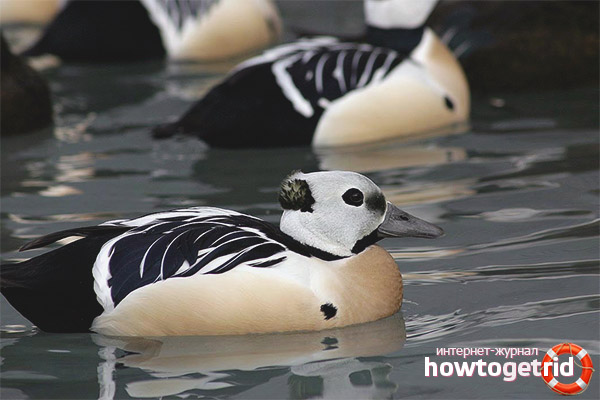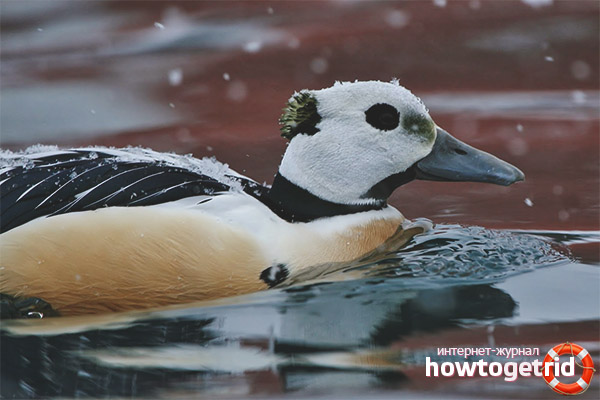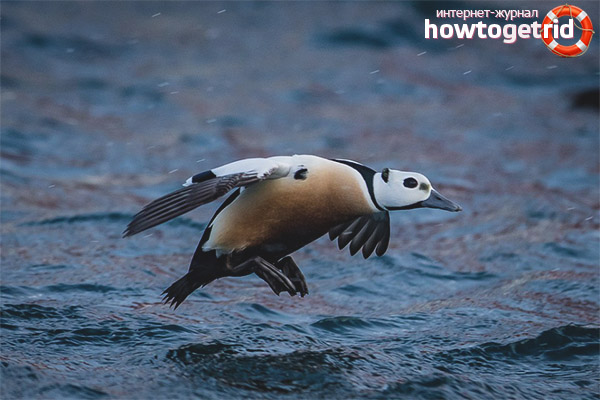The content of the article
The Siberian eider is a prominent representative of the Anseriformes order, which prefers to live on the Arctic coasts and in the tundra. Recently, the number of eiders has been falling sharply and individual representatives are noted on the Kamchatka Peninsula. An inconspicuous migratory duck was listed in the Red Book as a species requiring strict security measures.
Appearance
Siberian eider - a miniature representative of other eiders, visually commensurate with mallard. The size of her body does not exceed half a meter, and the wingspan reaches an average of 75 cm. The weight of medium-sized males varies in the range of 700-1000 g, while the females are even smaller - 400-700 g.
The female of the Siberian eider is darker than usual - its feathers are painted in brown or reddish tones with a characteristic transverse pattern. From afar, the head appears darker than the body (dark brown), and a white mask is visible around the eyelids. Visibly on the body is a blue mirror with a white border. The female does not change her plumage during the year.
Young eiders are slightly lighter than adult females, and their mirrors are dimmer.
The crest of young animals and adults in the summer plumage is visually less than that of the latter during the mating season. The underwings are also lighter, the beak and legs are gray with a blue tint.
Shedding in Siberian eiders occurs regularly twice a year, while the plumage is completely updated after mating. The main feathers partially change before the mating season.
Lifestyle and behavior
Researchers note that Siberian eiders are inconspicuous and calm, rarely give voice. They fly mainly at an altitude of up to 50 meters above the water surface, going down for active dives for prey. For most of its life, the bird prefers water over flights.
As food, the bird uses crustaceans and invertebrates (toads, mollusks, snails, etc.), insects (water meter, mosquito, caddis larva), as well as small fish and fry. Siberian eider also does not shun vegetable food - floating rdest, zoster, and algae are used.
Most birds live in separate individuals, rarely gathering in colonies (as a rule, for breeding, nesting and wintering).
The birds reach puberty by 3 years of life. After pairing, the Siberian eider forms nests, for which it seeks a floodplain sedge swamp or overgrown reservoirs. The nest is a small dug hole, which is well lined with moss, dried grass and brown fluff of the parents. Gaga lays an average of 6-10 small eggs with an olive or brown hue. Masonry incubation lasts up to a month, while the male immediately leaves the female (approximately mid-summer), flies to the sea and does not participate in the breeding of offspring. A female with young growth descends to small ponds and lakes, rolls chicks on their backs to their ability to independently ascend to the wing. In some cases, the brood merges.Males during this period move west along the coast, where they update their plumage.
Young birds, not ready for puberty, spend the whole summer on the sea coasts.
In the winter, Siberian eiders gather off the Baltic and Norwegian shores.
Habitat and conservation status

Birds prefer the Arctic shores of Alaska and Siberia for nesting. They often winter in the ice-free areas of the Arctic oceans and seas, the Kuril and Commander Islands, Kamchatka, and the coast of the Scandinavian countries.
The indigenous population of these places hunts for these quiet birds. They are shot from a gun along with other Arctic ducks (most often in the spring, because the rest of the time the eiders are invisible).
Other factors also affect the decline in the population of these ducks: predator press, climatic conditions, coastal pollution by oil products, human activities, and drainage of water bodies.
The Siberian eider was listed in the IUCN Red List in Yakutia, Kamchatka, and the Russian Federation.











Submit